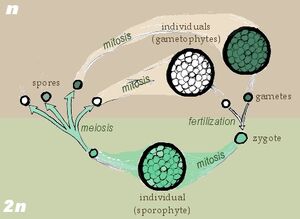
A Yeast Cross is how you take two haploid strains of yeast and create a diploid strain.
Yeast have two mating types; a and alpha. Although wild yeast can switch mating type, Our haploid lab strains are engineered to be unable to switch mating type, so they will stay either a or alpha depending on the strain. To do a cross you will need one a strain and one alpha strain; you cannot cross a with a nor alpha with alpha.
When you have single colonies of two haploid strains that you want to cross, you start the cross as early as possible during the day, as it takes about 6 hours and must be done in one day.
You'll need: toothpicks, YPD plates, use of the 30C incubator, your two haploid strains to be crossed, and some time on a dissecting scope at the end.
1. First, on a YPD plate, take a single colony of your first haploid strain and streak a small line of it about 5mm long, and then a simlar streak from the same toothpick on the other side of the plate. Always label on the plate what is where, including the mating type. We use a blue fine point sharpie for alpha, and a red for a, but even if you use colors, always also write out the mating types explicitly.
2. Then, for your second haploid strain, make a 5mm streak parallel to the first streak from the other strain, about 1mm apart, and a second streak far away from the second streak of the first strain. Now you should have two streaks of the two strains close to one another, and two streaks far from one another.

Plate Layout for yeast Crosses
3. Set a timer for 2 hours and leave the plate in the 30C Incubator for two hours. This allows the haploid strains time to reach a happy growing state on the plate.
4. Using a toothpick, mix together the two streaks that were close to one another. The far apart streaks are left alone as controls for the haploid growth. Set a timer for four hours and return the plate to the 30C Incubator for four hours, to allow the strains to mate and begin to produce discernible diploid zygotes.
5. After four hours, you'll pick the diplod zygotes. Using a toothpick, smear / streak out some of the cells from your mating patch onto a clean part of the plate, to spread the individual cells out a bit.
6. On a Dissecting Scope, look at the cells you just streaked. The easiest zygotes to spot will look like a three-lobed "Y" shaped structure. Pick these to clean spots of the plate using the dissecting scope. Although one surviving zygote is enough to generate your strain from, it's best to pick several to be safe. I like 9, in a 3X3 grid on the plate so I can see how they turned out.

This is what zygotes look like.
7. Return the plate to the 30C Incubator overnight, and check the next day to see if you have any growth. After one or two nights in the 30C you should have enough growth on successful colonies to proceed with your new diploid strain.
8. Once you've gotten your strain, parafilm the plate and store it in the 4C Cold Room for the time being until you are sure everything worked o.k., and also freeze your diploid strain, even if you plan to sporulate it to generate a new haploid strain.